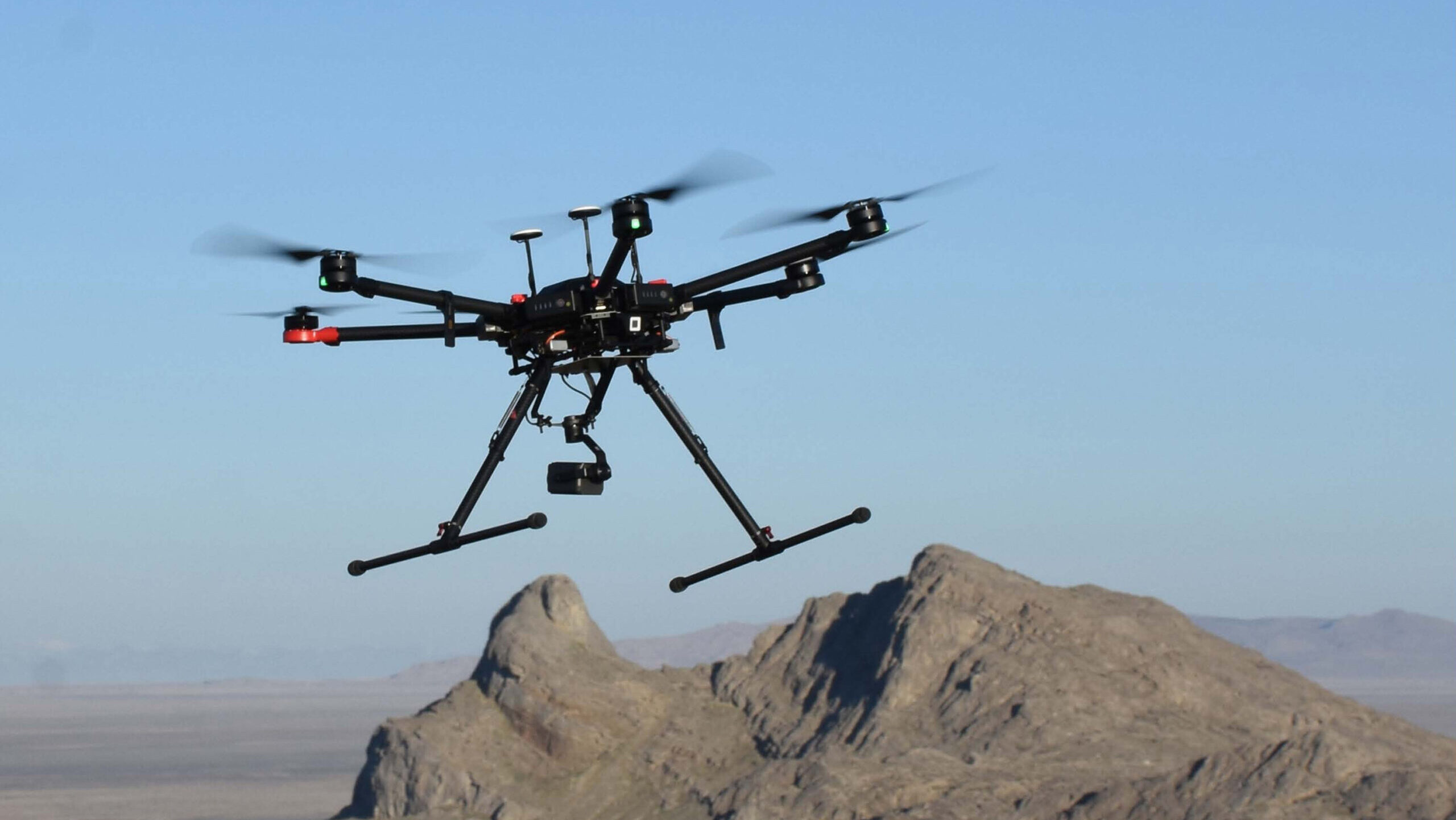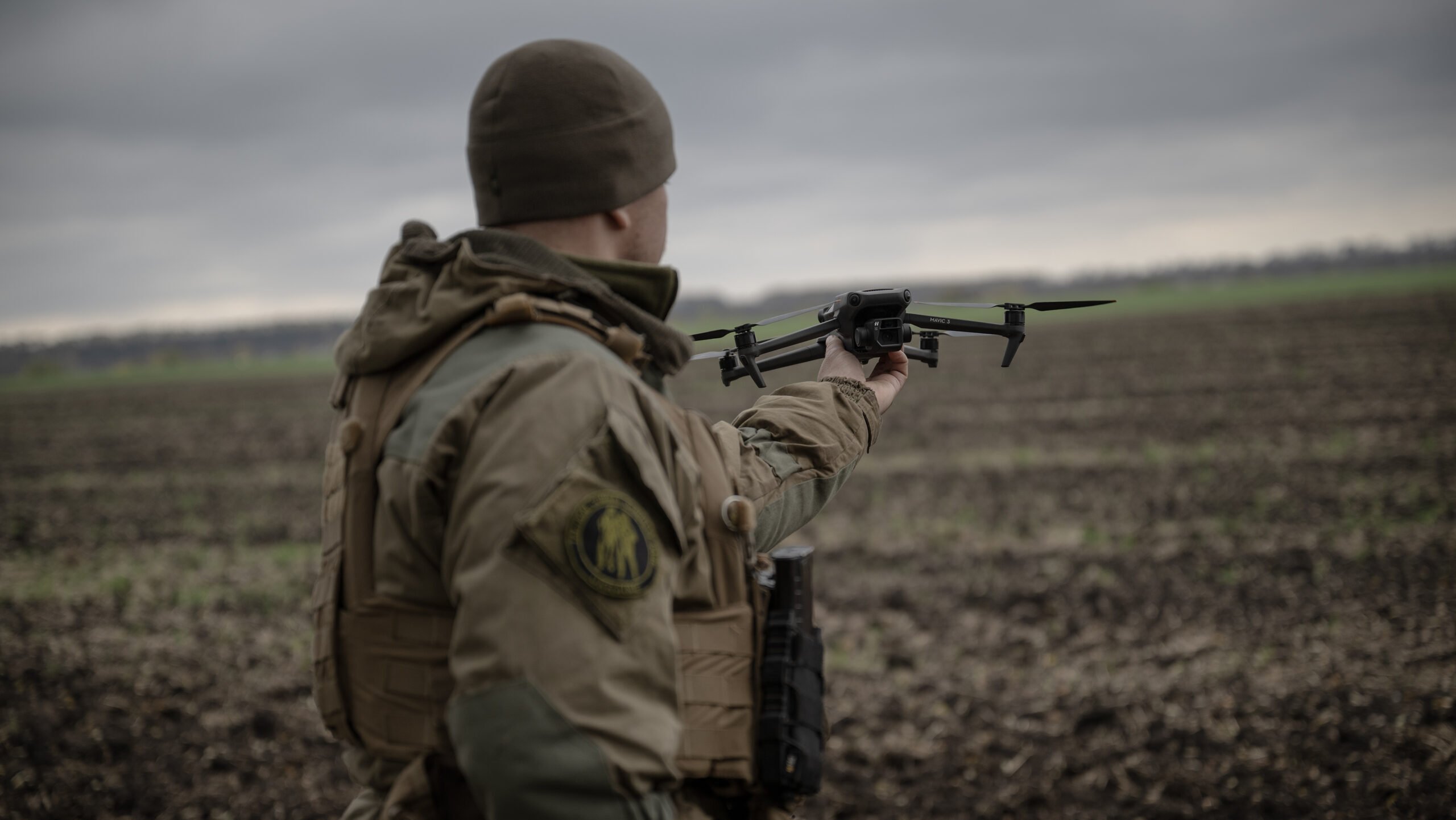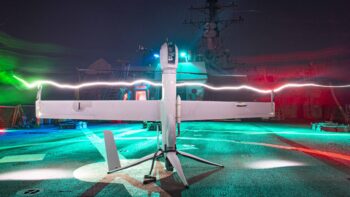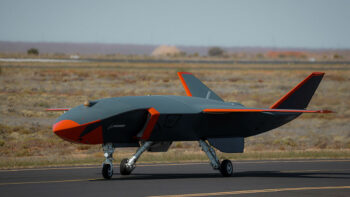
A small unmanned aircraft system (sUAS) is shown in flight at Dugway Proving Ground. (Photo by Becki Bryant)
The conflict in Ukraine has shown that uncrewed systems are no longer the future of war, but the present. The proliferation of drones has led Ukraine to dramatically change its approach to the technology, and in this new op-ed, US Army Lt. Col. Robert Solano argues that it’s time for the Pentagon to do the same.
The recent decision by President Volodymyr Zelenskyy of Ukraine to establish a separate branch within their armed forces dedicated to drone systems signals a significant shift in military strategy, and reflects an evolving battlefield where uncrewed systems play a pivotal role. This move, grounded in the hard-learned lessons of Ukraine’s ongoing conflict, should prompt a broader conversation about the future of warfare and the role of technology within it.
It also begs the question: Should the United States follow suit and establish its own service focused on uncrewed systems, regardless of operational domain? Or is there a different approach that better fits America’s military system but still allows uncrewed capabilities to reach their full potential?
Zelenskyy’s initiative is groundbreaking because it positions a drone systems force as a distinct entity alongside Ukraine’s established military branches. The United States military has traditionally categorized its forces based on operational domains — land, air, sea and, most recently, space — with the Army, Air Force, Navy, and Space Force, respectively. While the 2019 establishment of the Space Force illustrates the US military’s willingness to adapt to new operational realms, creating a separate service branch for uncrewed systems would represent a significant shift from this domain-based structure.
An approach that is more in line with the framework of the US military would involve the individual armed services — Army, Air Force, and Navy — each developing a specialized branch or career field focused on uncrewed systems (excluding space systems, which are uncrewed by nature and covered by the Space Force). Each service could harness its unique domain expertise to advance the integration and utilization of drones and autonomous systems.
Specifically, the Army should take the lead on land-based uncrewed vehicles and the smaller to medium-sized aerial drones that have become prominent in conflicts like the one in Ukraine. The first step would be to establish an Uncrewed Systems Branch that stands alongside the traditional Combat Arms branches like Infantry, Armor, and Aviation. This new drone corps would accelerate the adoption of uncrewed technologies, advance the development of new strategies, and improve talent management.
The use of uncrewed systems are not new to the US, leading to the obvious question of why this change is needed now. The reality is that the quantity and capabilities of drones, both air and ground, have increased significantly since the conflicts in Iraq and Afghanistan. As just one example, a coalition of European nations recently pledged to supply Ukraine with one million drones, highlighting the surge in drone utilization across various combat scenarios. Furthermore, the DoD last August announced its Replicator Program which seeks to field warfighters with thousands of autonomous systems.
Given the rapidly changing nature of warfare, small task forces and individual unit experimentation is no longer enough. The Army needs a professional drone corps as part of an uncrewed systems branch.
History provides a clear roadmap. When tanks were first introduced in World War I, they were initially assigned to infantry units in a supporting role, providing armored protection while breaching enemy lines. This limited their speed to that of foot soldiers and constrained their strategic potential. At the onset of World War II, military strategy evolved, recognizing that tanks offered new tactical advantages that infantry or horses could not. It was a learning curve that eventually led to the creation of the Armor Branch in 1940, fundamentally changing the dynamics of ground warfare.

The drone unit of the 108th Territorial Defense Brigade of the Ukrainian Army continues its combat training as heavy clashes continue on the Zaporizhzhia frontline in Ukraine on November 04, 2023. (Ozge Elif Kizil/Anadolu via Getty Images)
Drawing parallels to the present, drones and autonomous systems offer capabilities that extend beyond the traditional roles of aviation, armor, or infantry units. These capabilities include swarm attacks, persistent surveillance, psychological operations, electronic warfare, autonomous operations, and more. These tactics are reshaping the modern battlefield, as evidenced by their effectiveness in theaters like Ukraine. The unique potential of small and large drones to alter warfare demands a specialized focus that transcends their current role as mere enablers of existing combat arms branches.
Why start with the Army as a test case for a new drone corps? It’s multidomain nature and two decades of experience with a variety of systems makes it the obvious choice.
The Army already has experience in deploying uncrewed system forces. For instance, during the Global War on Terrorism in Iraq and Afghanistan, the Army formed Task Force ODIN, a battalion-sized unit with the mission to “observe, detect, identify and neutralize (ODIN) improvised explosive devices using both manned and unmanned aerial reconnaissance assets.”
While Task Force ODIN pioneered Army unmanned reconnaissance strategy, the presence of drones on the battlefield has increased exponentially since the conflicts in Iraq and Afghanistan.
Some units have already begun to incorporate smaller drones into their combat strategies. Recently, the 82nd Airborne Division used small drones to drop munitions during training, making them the first US Army unit to do so. The adoption of a drone branch could leverage the insights gained by the 82nd Airborne, as well as those acquired from allies and previous conflicts, to formulate a more comprehensive combined arms strategy.
However, establishing a separate Army branch for uncrewed systems is not just about recognizing their operational value. It’s about understanding the specialized skills and knowledge these technologies require. Today, drone operators represent a unique military occupational specialty, but the future will demand a broader array of expertise, including machine learning programmers, cloud technicians, specialized mechanics, and operators for more diversified systems. A drone branch would support specialized training and talent development. It would foster innovation and integration of uncrewed systems in ways we are only beginning to imagine.
Moreover, the establishment of a branch dedicated to uncrewed systems opens up new avenues for recruitment. The Army could tap into a growing pool of talent previously overlooked by traditional military branches. By actively seeking drone hobbyists and experts, the service can attract individuals with a passion for and expertise in drone technology and autonomous systems.
It’s important to acknowledge the ongoing discussions within the Army and Congress about whether different Army branches should have different physical fitness standards. For example, some have argued that cyber soldiers should have lower physical standards since they usually work behind desks away from combat. The specific physical fitness requirements for drone operators will depend on the development of drone doctrine and strategy. Notably, drone units in Ukraine frequently operate in close proximity to frontline action. If the US Army adopts similar tactics, we could expect the drone force to have higher physical standards than if they were operating remotely piloted drones from thousands of miles away.
It is also important to recognize that uncrewed air and ground systems often share underlying technologies, such as artificial intelligence for decision-making processes, sensor fusion for enhanced situational awareness, and secure communication networks for reliable control and data transfer. A unified drone branch could effectively synchronize military strategy and technology applications across the air and ground domains, ensuring that innovations and advancements in one area can be readily applied to the other. An Army uncrewed systems branch could also coordinate drone technology development and joint strategy between the Air Force, Navy, and Space Force.
Critics might argue that uncrewed systems are important enablers for other combat arms branches and that those combat units should retain ownership of their own uncrewed systems. Yet, the concept of specialized branches is not new to the Army, and those infantry, armor, aviation, engineer and other units could retain their uncrewed capabilities. The Signal Corps, for instance, is dedicated to communications and information systems, essential to all military operations yet distinct enough to warrant its own branch. Similarly, an uncrewed systems branch could operate both standalone drone units and provide specialized teams to support other combat units, ensuring that the unique capabilities of drones are integrated seamlessly across all domains of warfare.
The war in Ukraine has starkly illustrated the rapidly evolving nature of warfare, where drones and autonomous systems have become not just tools but game-changers on the battlefield. For the US Army to fully leverage the potential of these technologies, a dedicated branch could provide the focus, resources, and expertise required to integrate them effectively into the broader military strategy as part of the combined arms team.
About the author: Lt. Col. Robert Solano is the commander of the Defense Contract Management Agency at Boeing in Mesa, Arizona. He is a senior aviator and acquisitions corps officer in the US Army. You can follow him on LinkedIn. The views expressed in this article are the author’s own and do not necessarily reflect the views of any organization.
SOCOM tables amphibious MC-130J ambitions: Official
The command carried out steps like hydrostatic and wind tunnel tests, but are now “kind of hitting a pause” on implementing a water landing capability due to budget concerns.


























